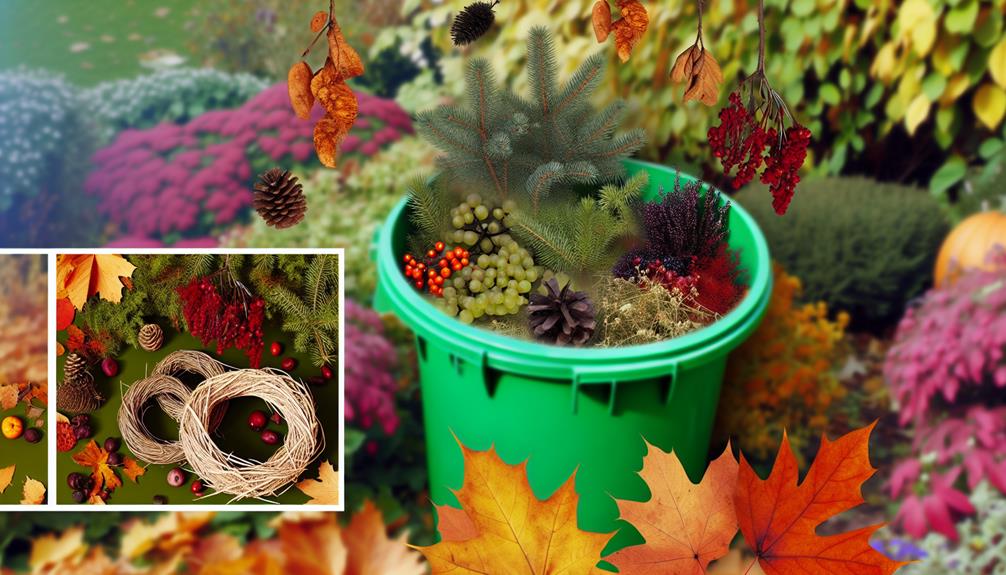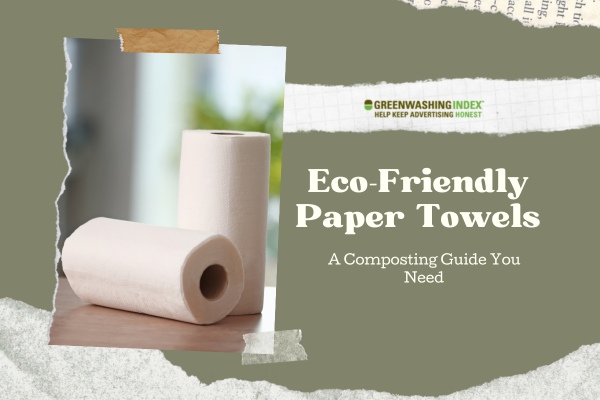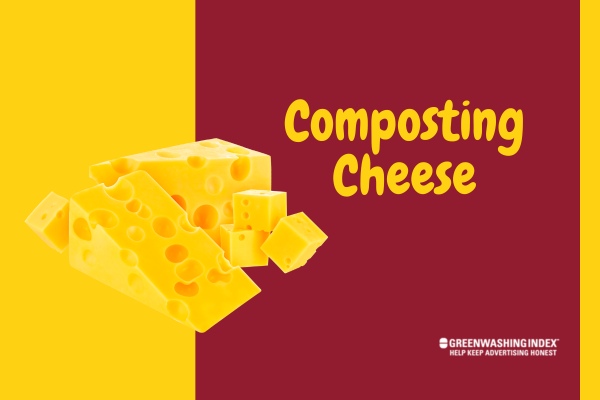Yes, you can compost a wreath if it’s made from natural and biodegradable materials like dried flowers, leaves, twigs, and pine needles. First, disassemble the wreath, separating organic components from non-compostable items such as plastic decorations and wire frames. Chop or shred larger natural parts to speed up decomposition.
Make sure you maintain a good balance of green (nitrogen-rich) and brown (carbon-rich) materials in your compost pile, and keep it moist for best breakdown. For plastic decorations and wire frames, recycle or dispose of them properly. To find more ways to repurpose and dispose of your wreath, continue on.
Understanding Wreath Materials
Understanding the various materials that make up a composting wreath is vital for creating an eco-friendly decoration. When you choose the right materials, you guarantee that your wreath not only looks beautiful but also aligns with sustainable practices. Material selection is essential. Opt for natural and biodegradable components like dried flowers, leaves, twigs, and berries. These elements break down easily and enrich your compost pile once the season is over.
Seasonal trends can influence your material choices, too. For example, in autumn, you might incorporate colorful leaves and pinecones for that festive touch. In winter, evergreen branches and holly berries become popular choices. By following these trends, you can make your wreath seasonally appropriate and visually appealing.
It’s also important to avoid materials that don’t compost well, such as synthetic ribbons or plastic decorations. These items can hinder the composting process and add unnecessary waste to your wreath. Stick to natural fibers like jute or cotton for tying elements together.
Composting Natural Components
When your wreath’s season ends, composting its natural components guarantees they return to the earth in a beneficial way. Start by identifying the natural fibers and organic matter in your wreath. Look for elements like pine needles, twigs, holly, ivy, and other plant materials. These components break down easily in a compost pile, enriching the soil with nutrients.
First, dismantle the wreath, separating the natural components from any non-compostable parts. Place the organic matter in a compost bin or pile. To accelerate decomposition, chop or shred larger pieces into smaller bits. This increases the surface area for microorganisms to work on, speeding up the composting process.
Mix these natural fibers with other compostable materials like kitchen scraps, leaves, and grass clippings. Maintain a balanced ratio of green (nitrogen-rich) and brown (carbon-rich) materials for best composting results. Turn the pile regularly to aerate it and promote microbial activity.
Keep the compost moist but not too wet. Over time, the organic matter will break down into rich, dark compost you can use to nourish your garden.
Also Read: Can You Compost Celery?
Dealing With Non-Compostables
Not all parts of your wreath can be composted, so it’s important to identify and properly dispose of non-compostable materials. Many holiday wreaths contain synthetic elements that won’t break down in your compost pile. Before you start, take a close look at your wreath and separate these items.
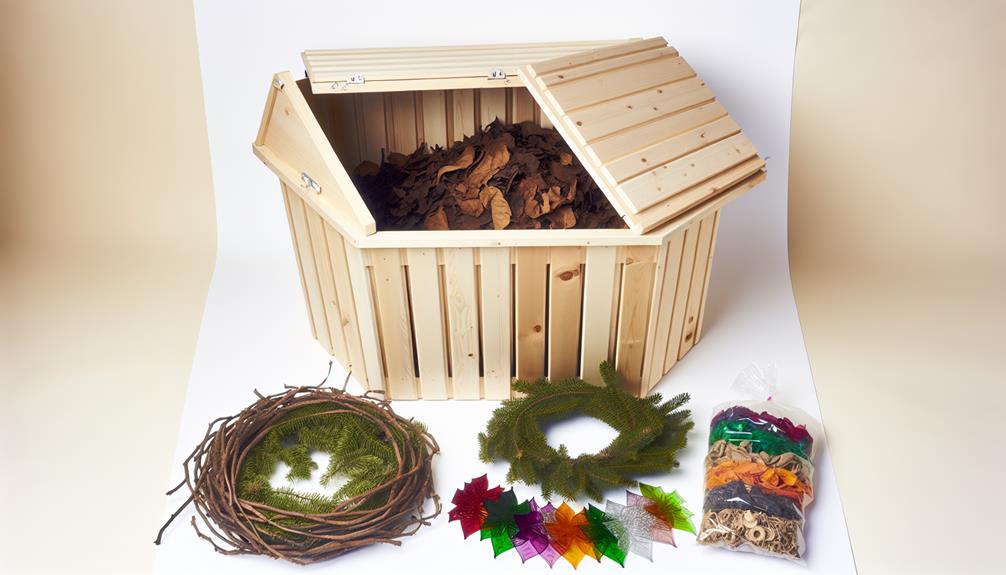
Here are some common non-compostable materials you might find:
- Plastic decorations: Ornaments, bows, and other synthetic embellishments that add festive flair.
- Wire frames: Used to hold the wreath’s shape, these don’t decompose.
- Glitter: Often found on artificial leaves or berries, glitter is a microplastic.
- Synthetic ribbons: These can be made from materials like polyester or nylon.
- Fake snow: Sometimes sprayed on for a wintery look, it’s usually plastic-based.
Proper holiday disposal of these synthetic elements is important. Place plastic items and wire frames in your recycling bin if they’re recyclable. Otherwise, they belong in the trash.
Prepping Your Wreath for Compost
Begin by removing any remaining non-compostable materials from your wreath. Carefully inspect your wreath and take off things like ribbons, plastic decorations, and metal wires. These items can’t break down in a compost pile and need to be disposed of separately.
Next, focus on wreath disassembly. Separate the natural materials from the base. Most wreaths have a frame made of wire or plastic, which you should set aside. Once you’ve got the natural components isolated—such as pine branches, holly leaves, and berries—you can move on to compost preparation.
Chop the natural materials into smaller pieces. This step is important because smaller pieces break down more quickly in your compost pile. Use garden shears or a pair of scissors to cut branches and leaves into manageable sizes. Aim for pieces that are no longer than a few inches.
After chopping, mix these materials into your compost bin. Balance the carbon-rich components (like dried leaves and branches) with nitrogen-rich components (like kitchen scraps).
Turn your compost regularly to promote even decomposition. By following these steps, you’ll efficiently transform your wreath into nutrient-rich compost for your garden.
Also Read: Can You Compost Basil?
Eco-Friendly Disposal Alternatives
While composting is a fantastic way to repurpose your wreath, there are other eco-friendly disposal alternatives you should consider. Choosing sustainable disposal methods helps reduce waste and minimizes your environmental footprint.
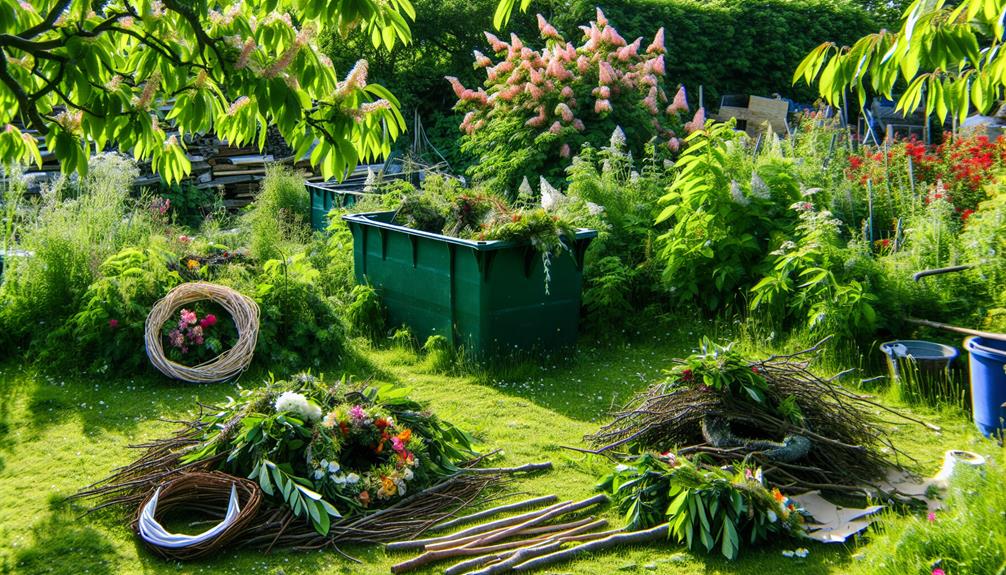
Here are some landfill alternatives you might find useful:
- Curbside Yard Waste Collection: Many communities offer curbside yard waste collection services. Simply place your wreath in the designated bin, and it will be taken to a local composting facility.
- Municipal Green Waste Facilities: Check if your city has a green waste facility where you can drop off organic materials for recycling into mulch or compost.
- Local Composting Programs: Some areas have community composting programs. Donate your wreath to these programs to make sure it gets composted properly.
- Treecycling Programs: After the holiday season, many municipalities run treecycling programs. They often accept wreaths and turn them into useful mulch.
- Chipping Services: Some local services offer chipping for yard waste. They’ll turn your wreath into wood chips that can be used in gardens or parks.
Also Read: Can You Compost Barbecue Sauce?
Creative Repurposing Ideas
You can give your old wreath a new life by upcycling its components into decorative home accents.
Transform the greenery and ornaments into unique garden art projects that add character to your outdoor space.
Use ribbons and other materials to create eye-catching designs that brighten up your living areas.
Upcycle Wreath Components
Transforming old wreath components into creative, new decorations is a fantastic way to upcycle and reduce waste. You can give your sustainable wreaths a second life by repurposing them into unique seasonal decorations.
Here are some simple ideas to get you started:
- Ornament Crafting: Turn small wreath pieces into charming ornaments. Add ribbons or small decorations for a personalized touch.
- Table Centerpieces: Arrange leftover wreath elements into elegant centerpieces. Combine with candles or vases to enhance your dining table.
- Gift Embellishments: Use sprigs of greenery or decorative items from your wreath to adorn wrapped gifts. It adds a personal, eco-friendly touch.
- Wall Art: Create a rustic wall hanging by arranging the components on a wooden board or canvas. This can be a beautiful, year-round decoration.
- Planters and Pots: Decorate your plant pots with bits of wreath material. It adds a natural, cohesive look to your indoor garden.
These ideas not only help you upcycle but also foster a sense of community and belonging by sharing sustainable practices. By creatively repurposing wreath components, you contribute to an eco-friendly lifestyle while keeping your home beautifully decorated throughout the year.
Decorative Home Accents
Ever wondered how to turn everyday items into stunning decorative home accents? With a bit of creativity, you can repurpose elements from old wreaths into unique pieces that align perfectly with current holiday decor and seasonal trends.
Start by salvaging items like ribbons, pinecones, and faux berries. These can be used to enhance centerpieces, create custom napkin rings, or even embellish photo frames.
Consider integrating wreath components into your holiday decor by crafting festive garlands. Take strands of ribbon and intertwine them with pinecones and ornaments to create eye-catching mantel decorations. This not only saves money but also adds a personalized touch to your home.
You can also adapt these ideas for different seasonal trends. For instance, during the fall, use acorns and autumn-colored ribbons to create a rustic table runner. In spring, freshen up your space with floral accents repurposed from your wreath.
Garden Art Projects
Turn old wreaths into whimsical garden art by repurposing elements like wire frames, faux flowers, and natural accents. You can breathe new life into these materials with a bit of creativity and some simple techniques.
Here are a few ideas to get you started:
- Wire Frames: Transform them into plant supports or decorative trellises for climbing plants.
- Faux Flowers: Use dye techniques to refresh their colors and create vibrant, seasonal themes.
- Natural Accents: Incorporate pinecones, twigs, or dried leaves into garden pathways or as mulch.
- Ribbons and Bows: Repurpose as ties for staking plants or to add a decorative touch to garden tools.
- Mini Ornaments: Embed them in garden beds as charming focal points or use them to decorate potted plants.
Frequently Asked Questions
How Long Does It Take for a Wreath to Decompose in a Compost Pile?
Understanding the wreath lifespan in your compost pile is crucial. Seasonal decomposition varies, but typically, it takes about 6 months to a year. You’re part of a community that values sustainability and patience.
Can I Compost a Wreath in a Small Indoor Compost Bin?
You can compost a wreath in a small indoor compost bin. Just make sure the wreath ingredients like natural foliage and biodegradable materials are suitable for indoor composting. With your group’s effort, you’ll promote a sustainable, eco-friendly environment.
Are There Any Wreath Materials That Attract Pests When Composted?
When composting wreaths, avoid using organic attractants like fruit or sugary decorations that attract pests. Opt for pest-resistant materials such as pinecones or dried flowers. It helps keep your compost bin community-friendly and pest-free.
Can Wreaths With Synthetic Decorations Harm My Compost?
Yes, wreaths with synthetic decorations can harm your compost. Synthetic chemicals in these decorations may negatively impact the environment and disrupt the composting process. Stick to natural materials to keep your compost eco-friendly and safe.
What Are the Signs That a Wreath Is Breaking Down Properly in Compost?
You’ll know a wreath is breaking down properly in compost when you see it turning into dark, crumbly material. Confirm proper moisture and correct temperature by checking it’s damp like a wrung-out sponge and warm.
Conclusion
To compost your wreath, first identify and separate natural materials from non-compostables. Remove wire, synthetic ribbons, and plastic decorations, as these can’t break down organically.
Compost the greenery, pinecones, and other plant-based items. If composting isn’t an option, consider eco-friendly disposal methods or creative repurposing ideas.
By following these steps, you’ll guarantee a sustainable and environmentally-friendly end for your holiday decorations.

